It’s hard to imagine a world without flowers. Their colours and form, as well as the memories flowers hold, have meaning and appeal for most of us. From their natural vibrancy or pastel hues, to their unique shapes and sizes and their symmetry and spiralling centres, there is so much to see in a flower, and that is why they’ve featured in art across the ages.
Textile art is no different and we discovered artists using a range of techniques to depict flowers using fabric, thread and mixed media.
Notice the colours and textures in the sunflower art quilt of Susan Brubaker Knapp, the purity of the lotus flower made in Tibetan appliqué thangka by Leslie Rinchen-Wongmo, cow parsley in wire and crocheted thread by Liz Cooksey, the drifts of meadow flowers stitched into felt by Lynn Comley and the stunning and vibrant Cape of Empowerment from Louise Gardiner.
Each artist offers a different textile take on flowers – can you pick a favourite?
Susan Brubaker Knapp
Susan Brubaker Knapp’s art quilts are colourful, intricate and never fail to draw the eye – just like the flowers that she often chooses as the perfect subject.
Susan started making traditional quilts in her twenties and moved on to make her first art quilts in 2005. Her interest in botany heavily influences her choice of subject, and her solo show at the North Carolina Botanical Garden in Chapel Hill in early 2022 focused on native plants.
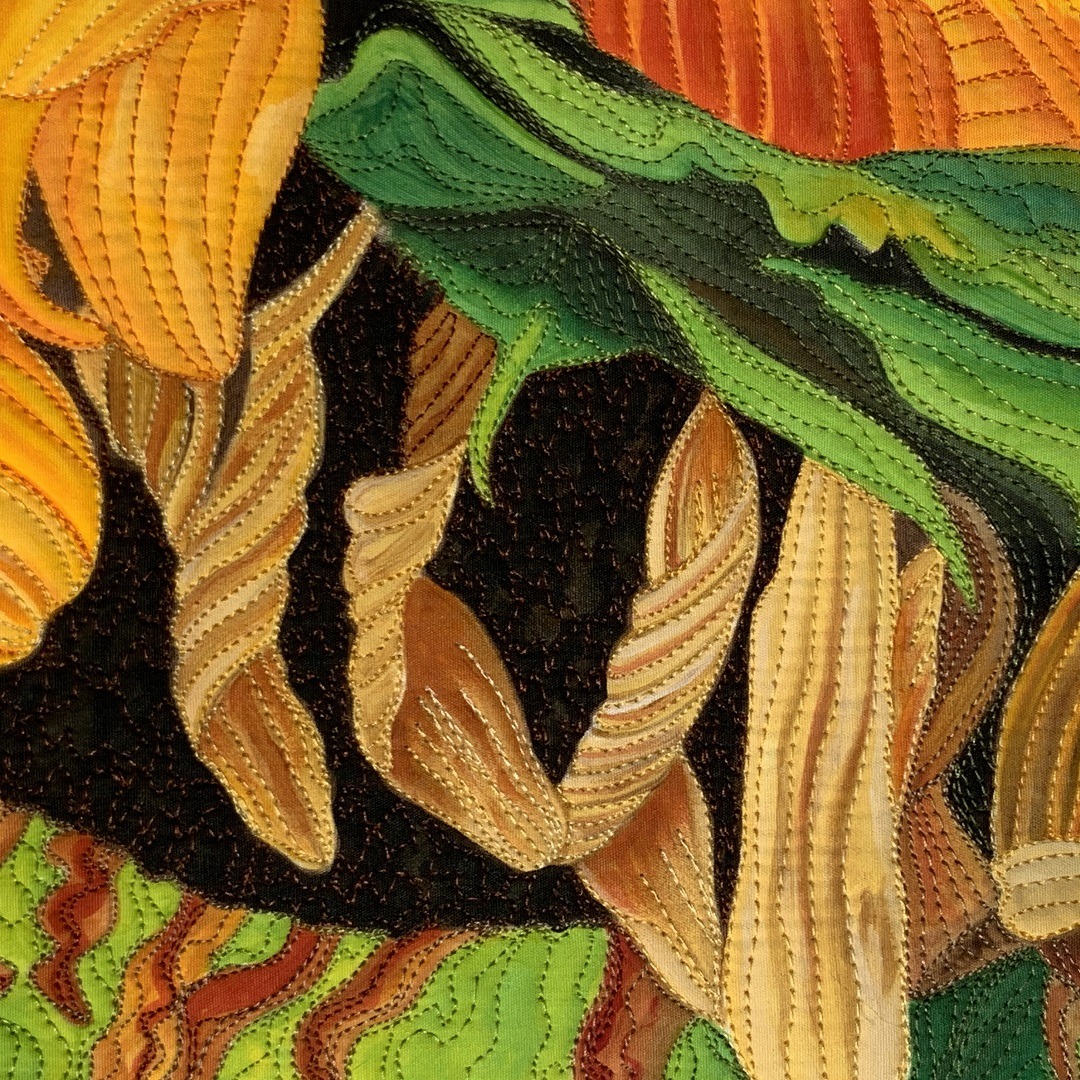
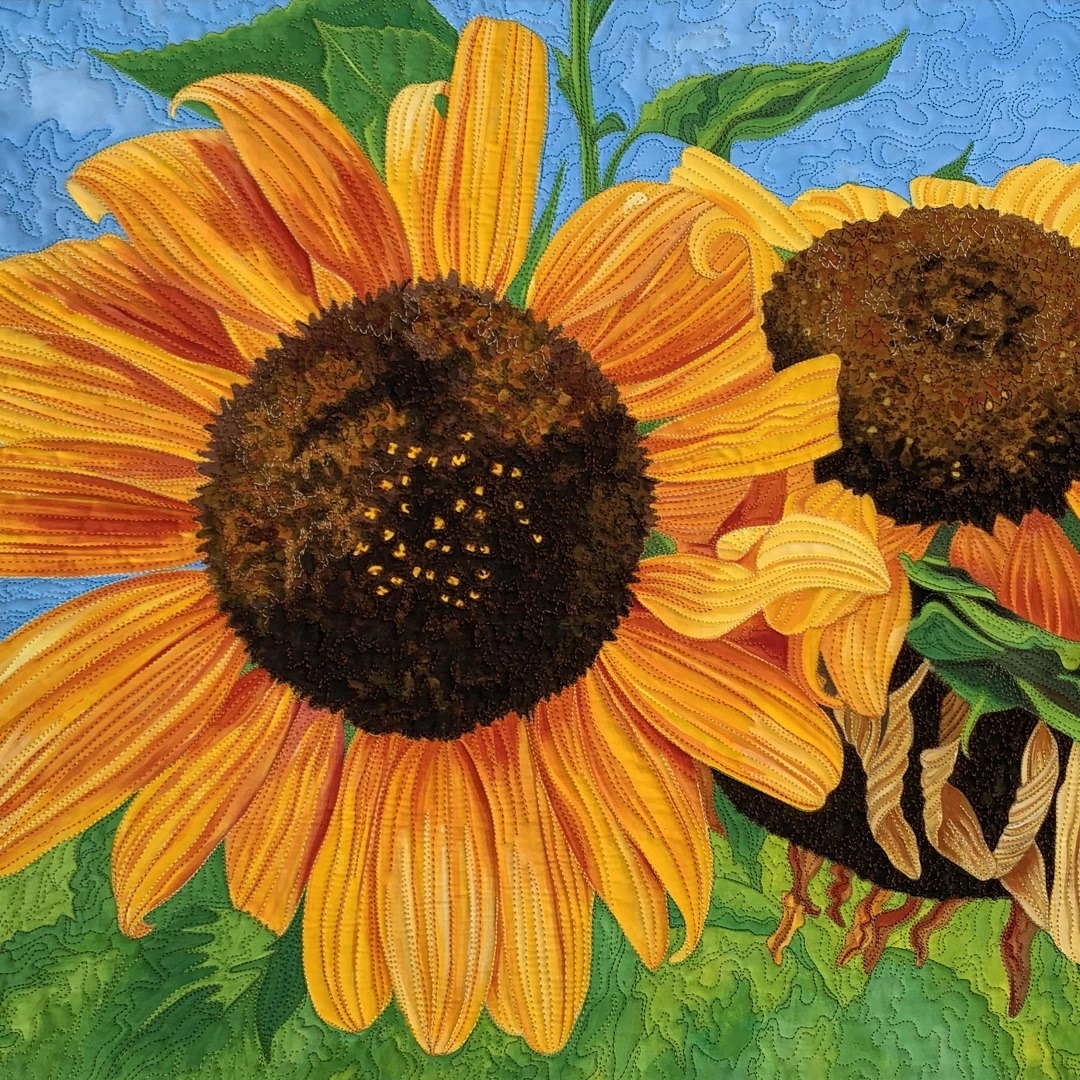
A quilt with heart
For Ukraine is Susan’s colourful portrait of a sunflower, a quilt that she started the week Russia invaded Ukraine.
Susan Brubaker Knapp: ‘As I watched the news nonstop, I was deeply moved by the plight of the Ukrainian people. I needed to work to do something productive and decided to create a sunflower piece, as the sunflower is a symbol of Ukraine.
Most of Susan’s work is realistic and representational in style. She uses two primary techniques – whole cloth painting, and fused appliqué – and often thread sketches the surface heavily with free-motion embroidery before quilting. She’ll sometimes use fabric paints and dyes, Tyvek, Angelina fibres and water-soluble wax pastels to transform the surface.
Her aim is to create works that draw people closer and invite them to savour the colour, texture and form. She often explores environmental, political and social issues and likes to celebrate and document the mysteries of the world that can only be experienced by close inspection of the miraculous details of nature.
Susan had taken the sunflower photo in her neighbour’s garden several years ago and realised it was the perfect inspiration for For Ukraine.
‘I created a black-and-white line drawing from the photo, enlarged it, and placed it under white cotton fabric. This way, I have the main lines from my drawing and I can paint on top of the fabric with these lines to guide me. I used acrylic textile paint by PRO Chemical & Dye. Once that was dry, I layered the cotton fabric with batting and backing fabric, and then free-motion machine quilted it.’
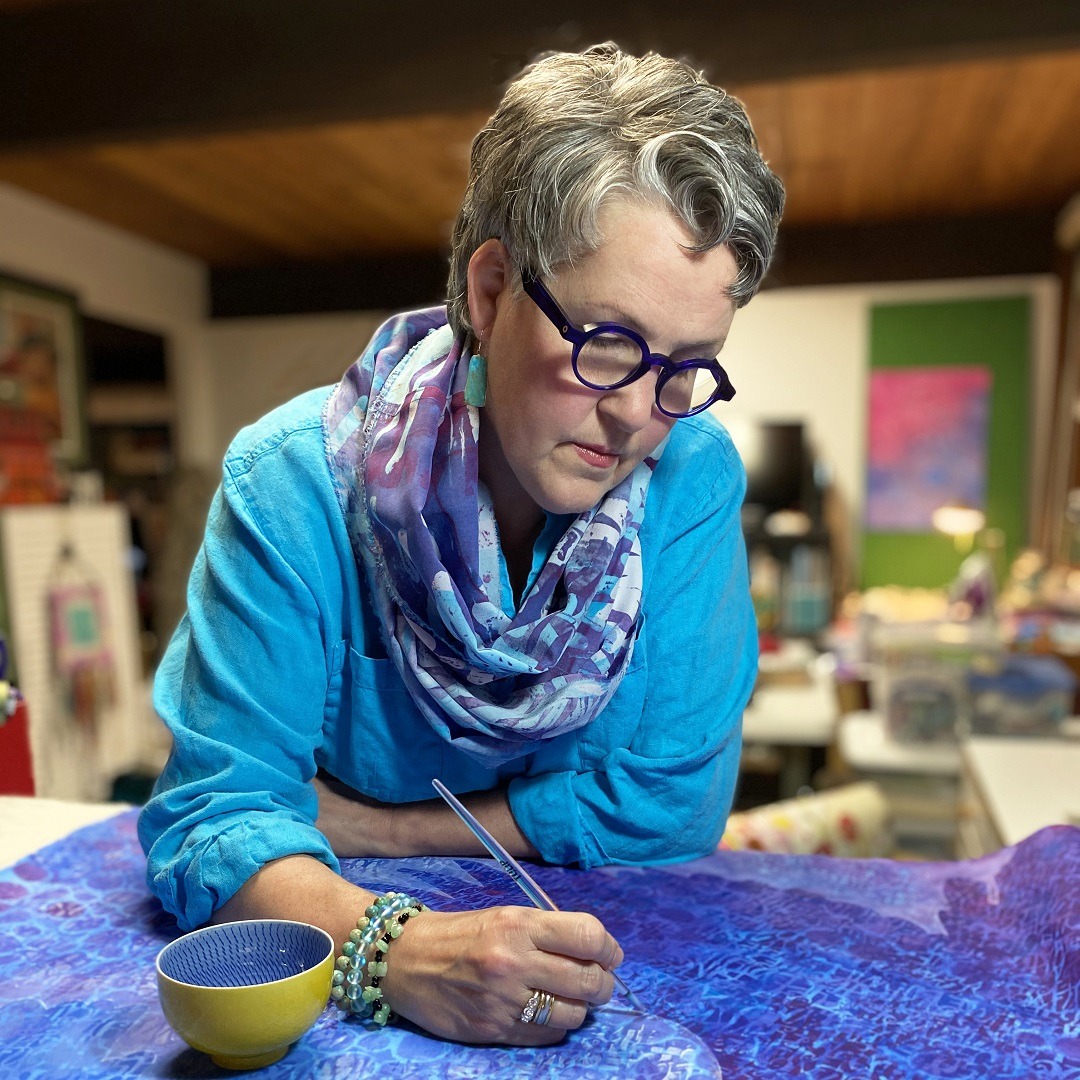
Susan Brubaker Knapp is based in Chapel Hill, North Carolina, USA. She works in fabric and thread and uses paint and fused appliqué to make art quilts for exhibition, for sale and to commission.
Website: susanbrubakerknapp.com
Facebook: facebook.com/SusanBrubakerKnappFiberArtist
Instagram: @susanbrubakerknapp
Leslie Rinchen-Wongmo
When Leslie Rinchen-Wongmo bought a one-way ticket from California to Dharamsala, India to volunteer for the Tibetan administration, she found herself in a Tibetan sewing workshop next door to the Dalai Lama. Over the next four years, she was trained by two of the finest living Tibetan appliqué artists to master the Buddhist art of silk appliqué thangka, a form of textile art that brings the transformative images of Buddhist meditation to life.
The lotus flower – a prominent symbol in Buddhist art – grows in muddy ponds and emerges from the cloudy water unmarred, pure and radiant. For this reason they represent each individual’s Buddha nature – something that remains uncontaminated by the chaos of the world.
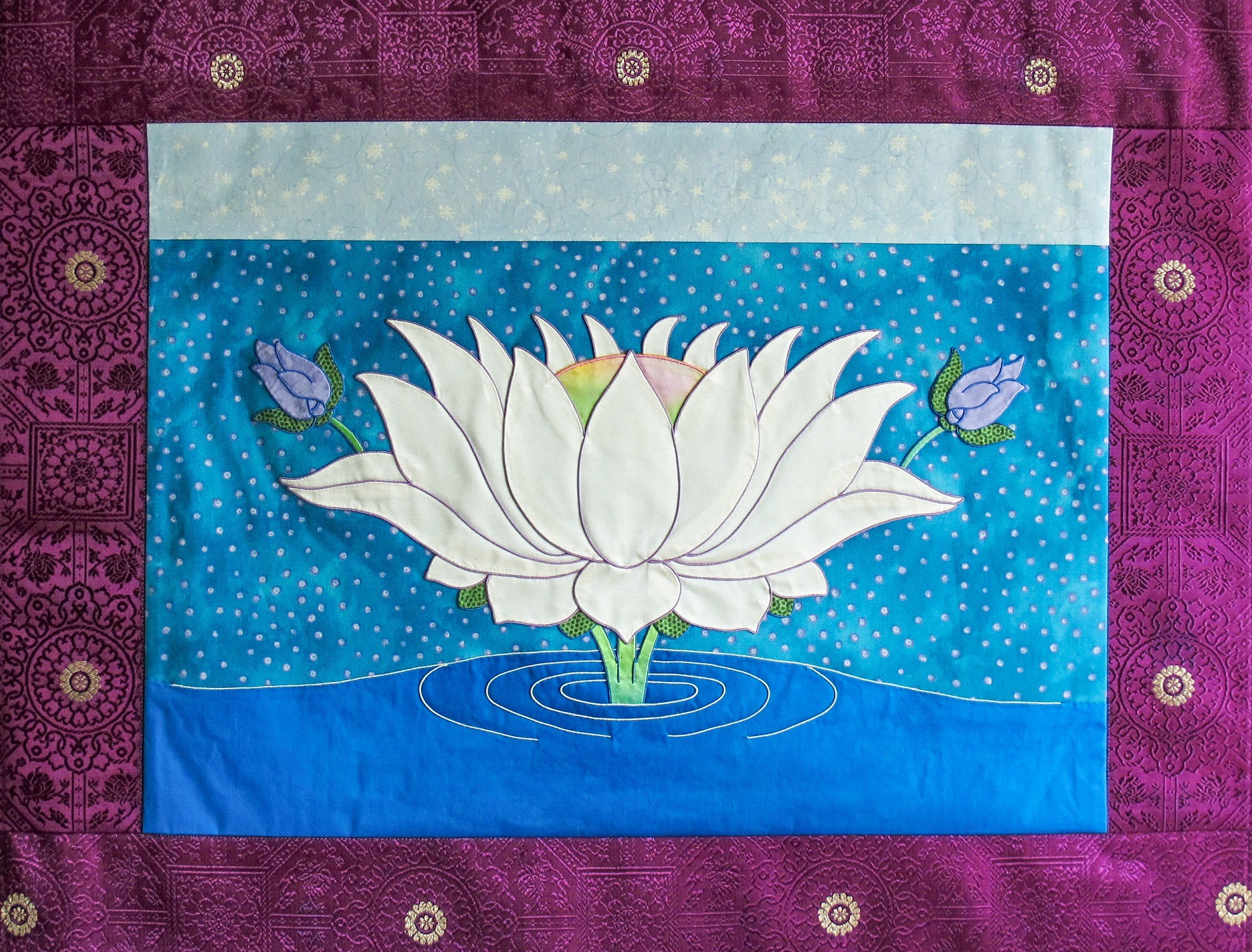
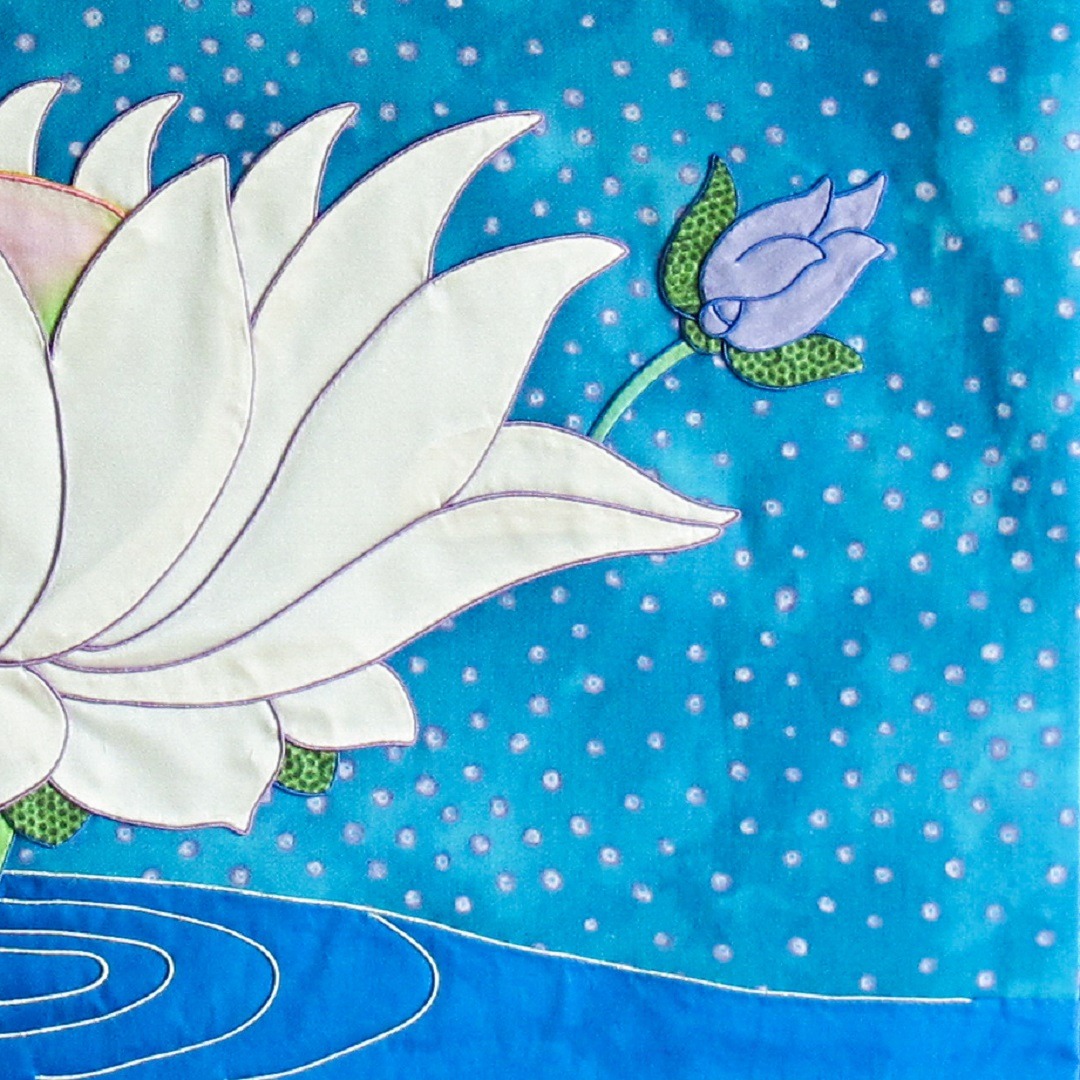
Silk and horsehair
Leslie made Marlena’s Lotus when she took part in a three-year programme that combined meditation, movement, inner inquiry, and communication practices. A colleague, Marlena, had adored one of Leslie’s thangkas and requested she create a simpler, more affordable piece that would evoke similar spiritual teachings. They agreed on a white lotus in a jewel-tone setting.
Leslie Rinchen-Wongmo: ‘I set to work and let my fabrics guide me. I started with a master drawing as a template and map but which did not become part of the finished piece. I transfered segments of the drawing to variously coloured pieces of silk satin and brocade and some cotton fabric. Then, I created coloured cords by wrapping silk threads around strands of horsehair. I used the same silk thread to couch the cords along the lines. I cut the pieces out and turned their edges under, then assembled them like a jigsaw puzzle, using the drawing as a guide.
‘For each thangka pieces overlap. There is no foundational background cloth. I use couching stitches along the horsehair-cord lines to stitch through layers and connect the pieces. Pieces are, thus, held together by their interconnections to create a whole image.
‘I completed the background of Marlena’s Lotus with a sky of quilting cottons and framed it in purple and gold brocade.’
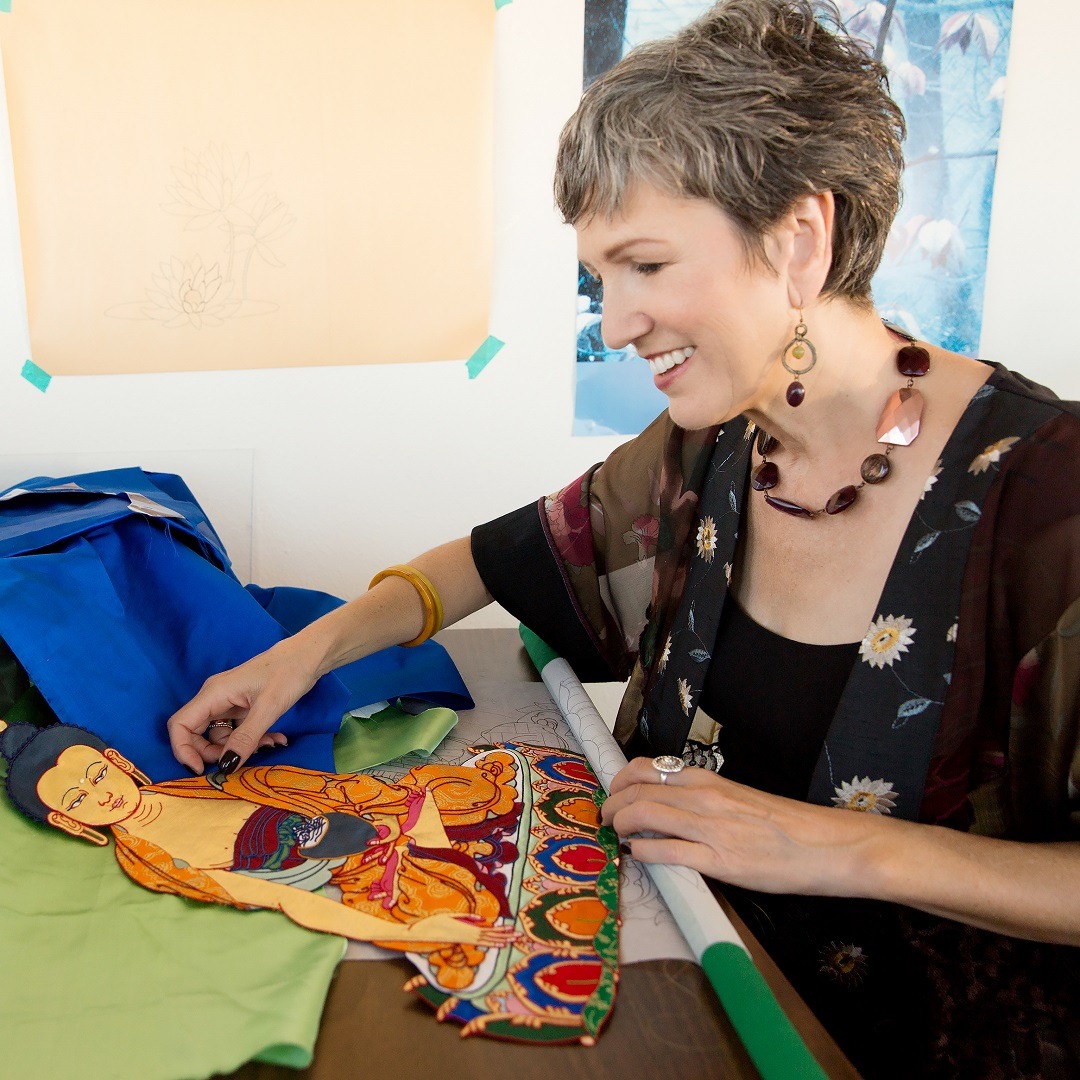
Leslie Rinchen-Wongmo is based in Oxnard, California, USA. She is one of very few non-Tibetans to have learned the ancient Buddhist art of appliqué thangka and is the author of Threads of Awakening: An American Woman’s Journey into Tibet’s Sacred Textile Art with a foreword by the Dalai Lama.
Website: threadsofawakening.com
Facebook: facebook.com/LeslieRW
Instagram: @lesrinchen
Louise Gardiner
From embroidered illustrations to large-scale artworks and commemorative capes, the dynamic works of ‘contemporary embroideress’ Louise Gardiner showcase the highest levels of craft and artistry.
What you notice about Louise’s artworks is how they shimmer in the light with an almost fairytale-like quality, built up with layers of appliqué, inks and paints, and hours of meticulous stitching of beads, sequins and sparkly threads. Her first piece of wearable art, the Cape of Empowerment, embodies her many techniques.
The dynamism of Wonder Woman
The cape was first imagined when Pukka Herbs approached Louise to collaborate on their international campaign celebrating women and highlighting its range of teas and supplements that combine ingredients known for their ability to support female health.
Louise Gardiner: ‘I could not have anticipated the serendipities that would result in my piece of wearable textile art, the Cape of Empowerment.
Initially, I wondered how to produce an artwork picturing a woman, but a cinema visit gave me a new vision — as Wonder Woman swooped across the screen, I noticed her cape.
I had to laugh! I was sitting there, punching the air, remembering how as a kid I wanted to be a superhero – and I thought: I absolutely have to do a cape! But not just any old cape — it was to be a ‘Cape of Empowerment!’, adorned with stitched images of the many herbs, plants and flowers in Pukka’s Womankind tea.’
To gain first hand experience of Pukka’s herbs, Louise visited the garden run by their co-founder and master herbsmith, Sebastian Pole. She gathered a large bunch of the ancient healing herbs and vegetable leaves Pukka put into their tea: 21 in total, from beetroot and chamomile to shatavari root and calendula.
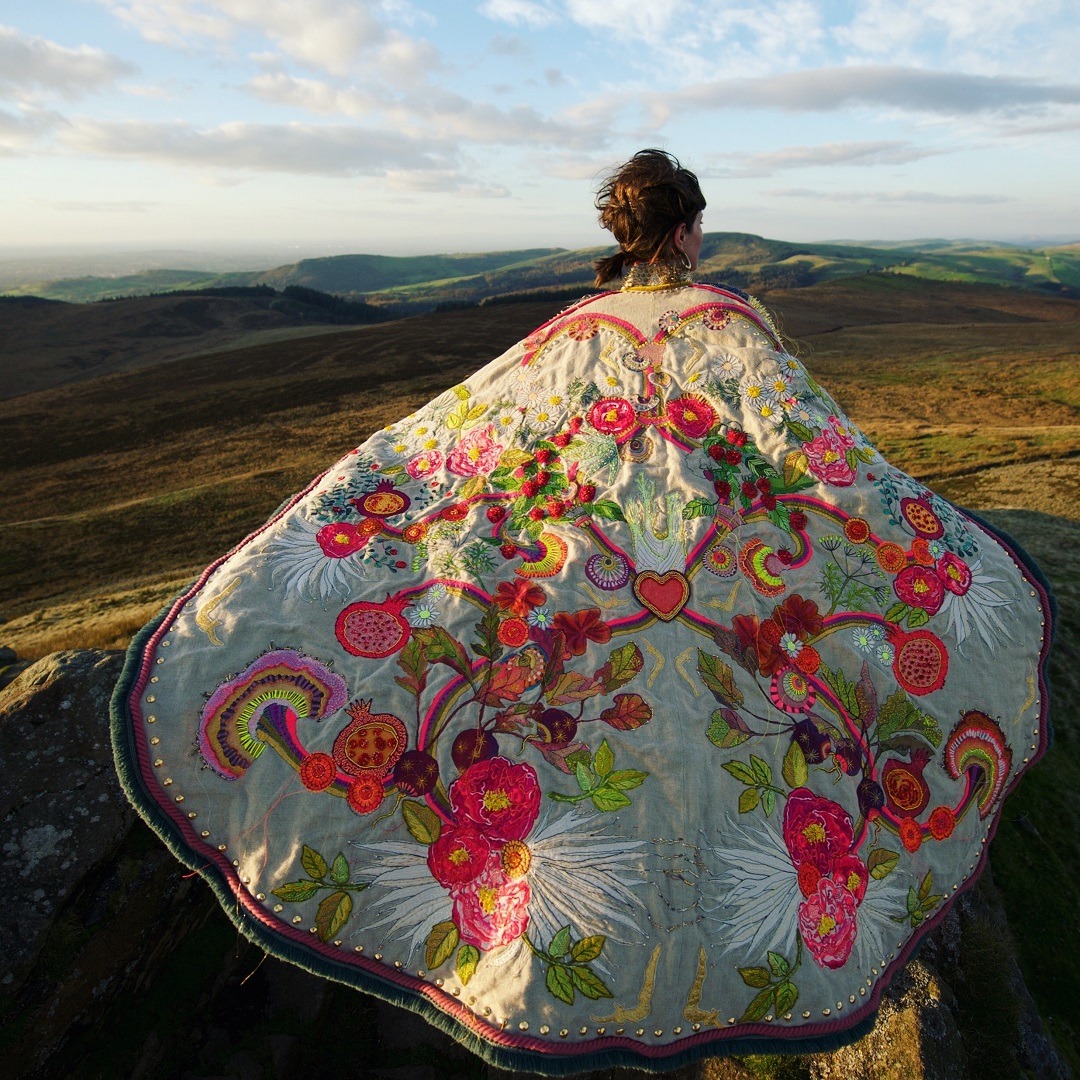
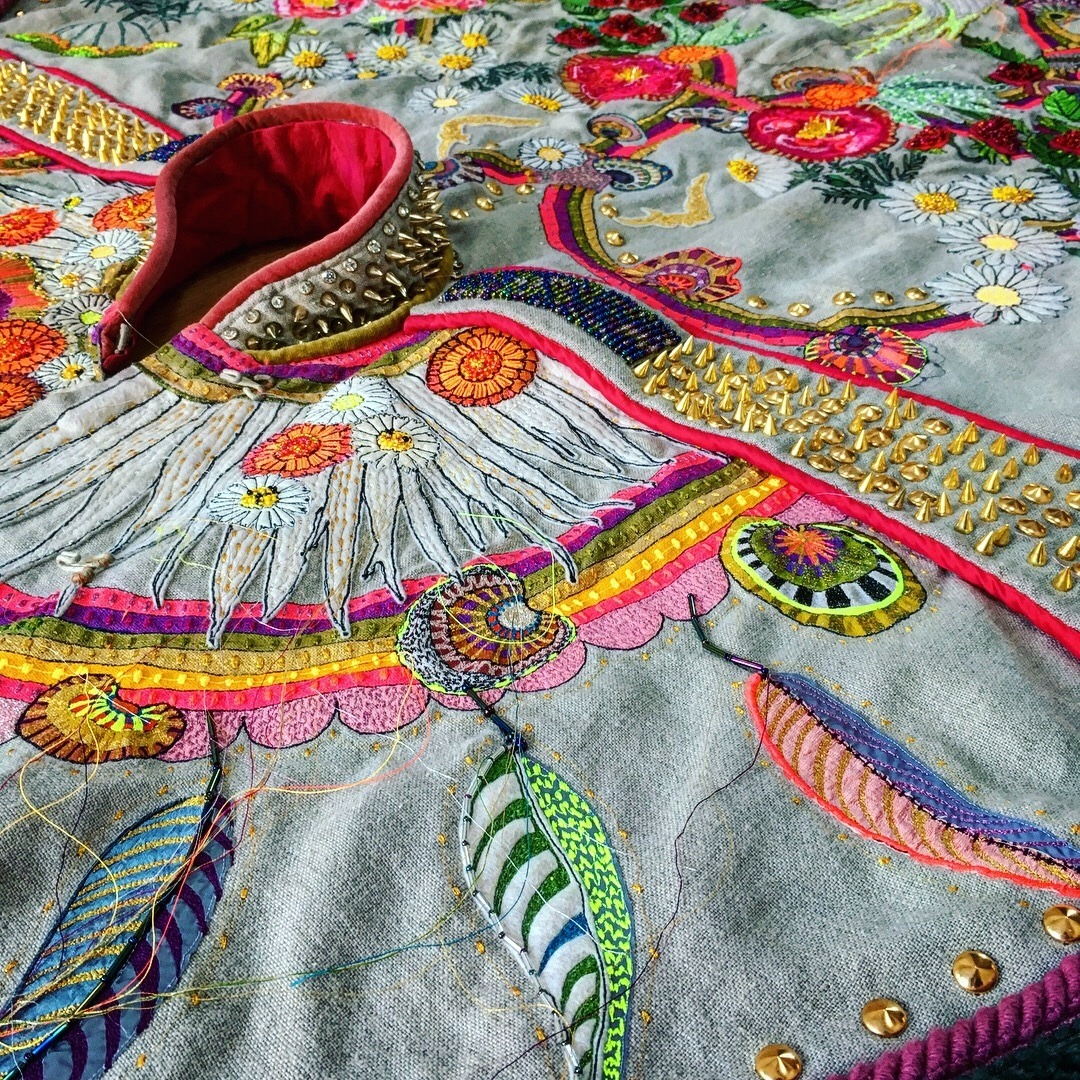
Herbal wall of protection
Louise: ‘This was to be my first wearable work of art and I knew from the start that I wanted it to be floor length to ground the wearer to the earth, like a herbal wall of protection and a glamorous yet humble celebration for that person.’
The Cape of Empowerment is a large piece made of linen and silk and is adorned with embroidered, vividly coloured appliqué, painting and hand beading. A gold studded and beaded collar and epaulettes and high vis fabric and fringing make this piece wonderfully humble and gloriously rockstar at the same time.
Louise: ‘I wanted the cape to be worn as widely as possible, and it went to the Bath Film Festival to the ‘Stylist Show’ in London and to Sweden. It was draped over the shoulders of women in a hospice and of groups of adults with learning disabilities; it visited Women’s Institutes and has been worn with great pride by a 95-year-old lady in my village, Betty.
‘I feel it gathers energy and magic with every wearer (both men and women), empowering each to feel like the incredible life of unique experiences that they truly are.’
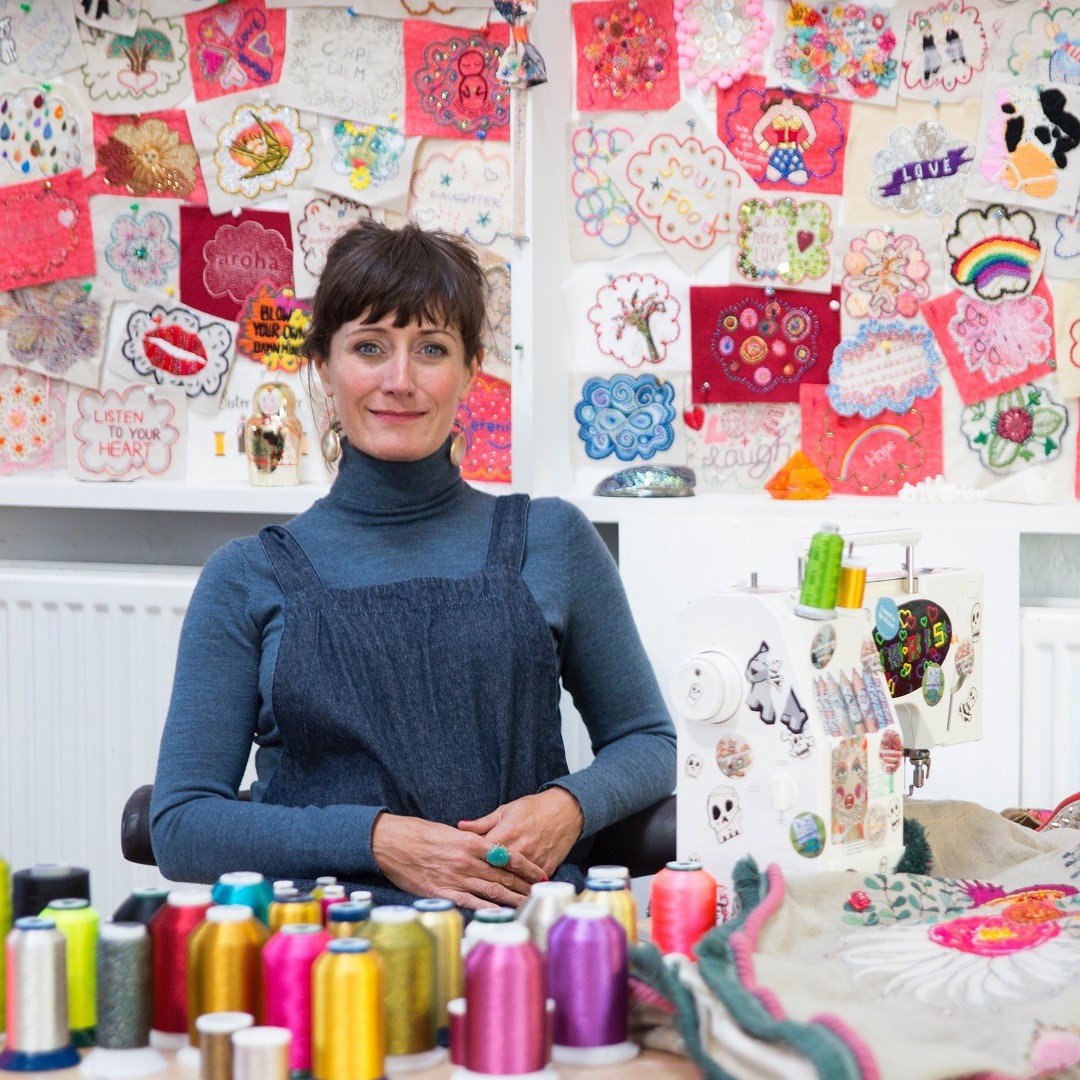
Louise Gardiner graduated with a BA Hons in Fine Art Textiles at Goldsmiths in 1996 and an MA in Illustration in 2004 from Manchester Metropolitan University.
She maintains a full-time studio practice in Bristol and has shared her work in talks and workshops in India, France, New Zealand and Australia.
Louise continues to create exclusive embroidery and appliqué artworks for exhibitions and to commission and has her own British luxury product range, Lou Gardiner Silks and Velvets.
Her campaign for 2022/ 23 ‘The Cape of Creative Courage’ celebrates creativity, our connection with the environment and involves international stitchers in a parallel campaign called ‘Stitch an Acorn’ to be exhibited at Marchmont House in Scotland.
Website: www.lougardiner.co.uk
Instagram: @lou_gardiner_embroidery
Liz Cooksey
Nature-inspired floral art, created in wire and thread, describes the intricate and delicate works of Liz Cooksey.
Her two and three dimensional artwork combines the simplicity of the leaves and flowers found in hedgerows and roadside verges with the simplest of materials. She is informed by the architectural structure and symmetry of shapes and pattern, along with the abundance of colour and beauty in flowers.
Hedgerow was inspired by the onset of spring and the appearance of cow parsley after the more desolate foliage of winter.
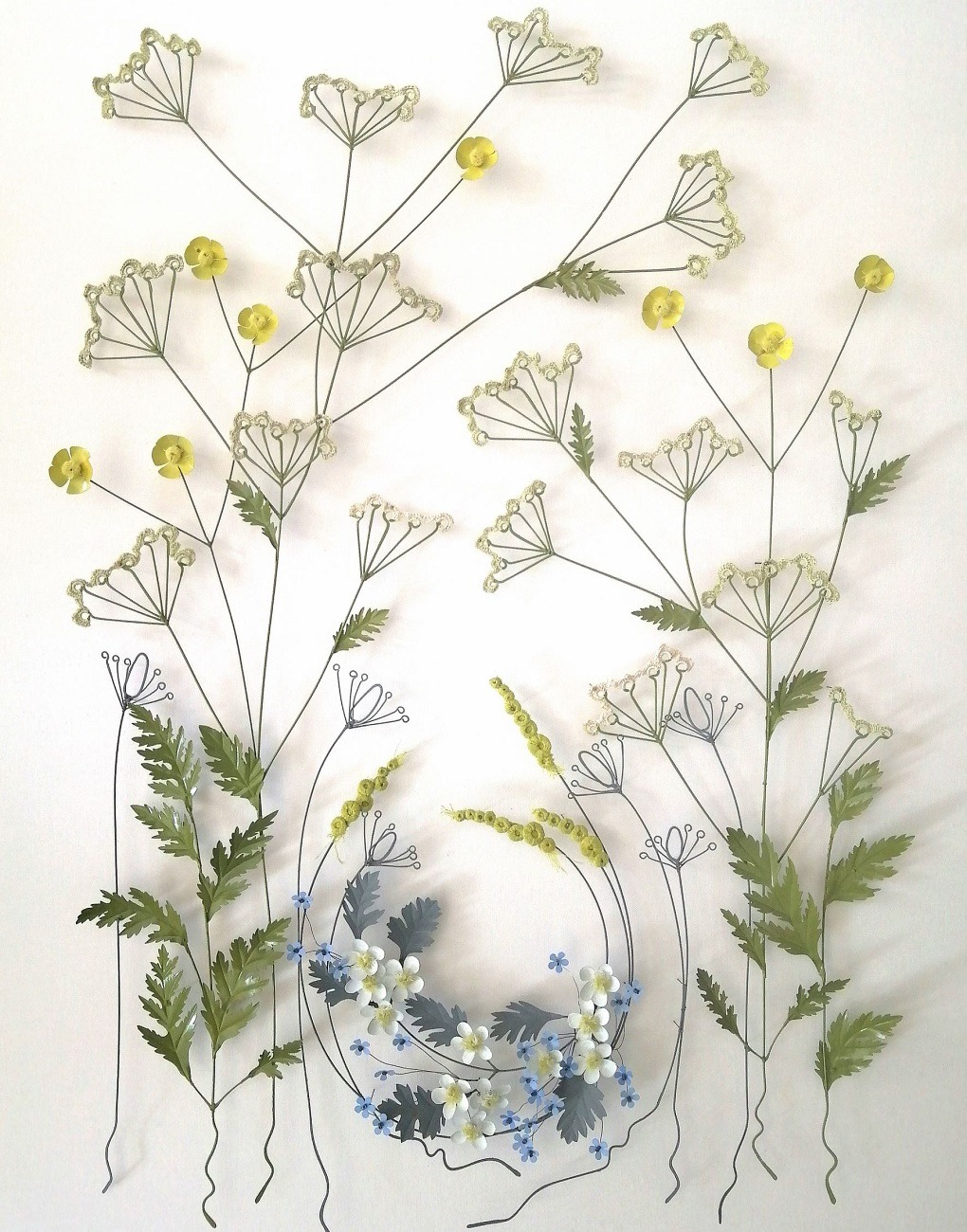
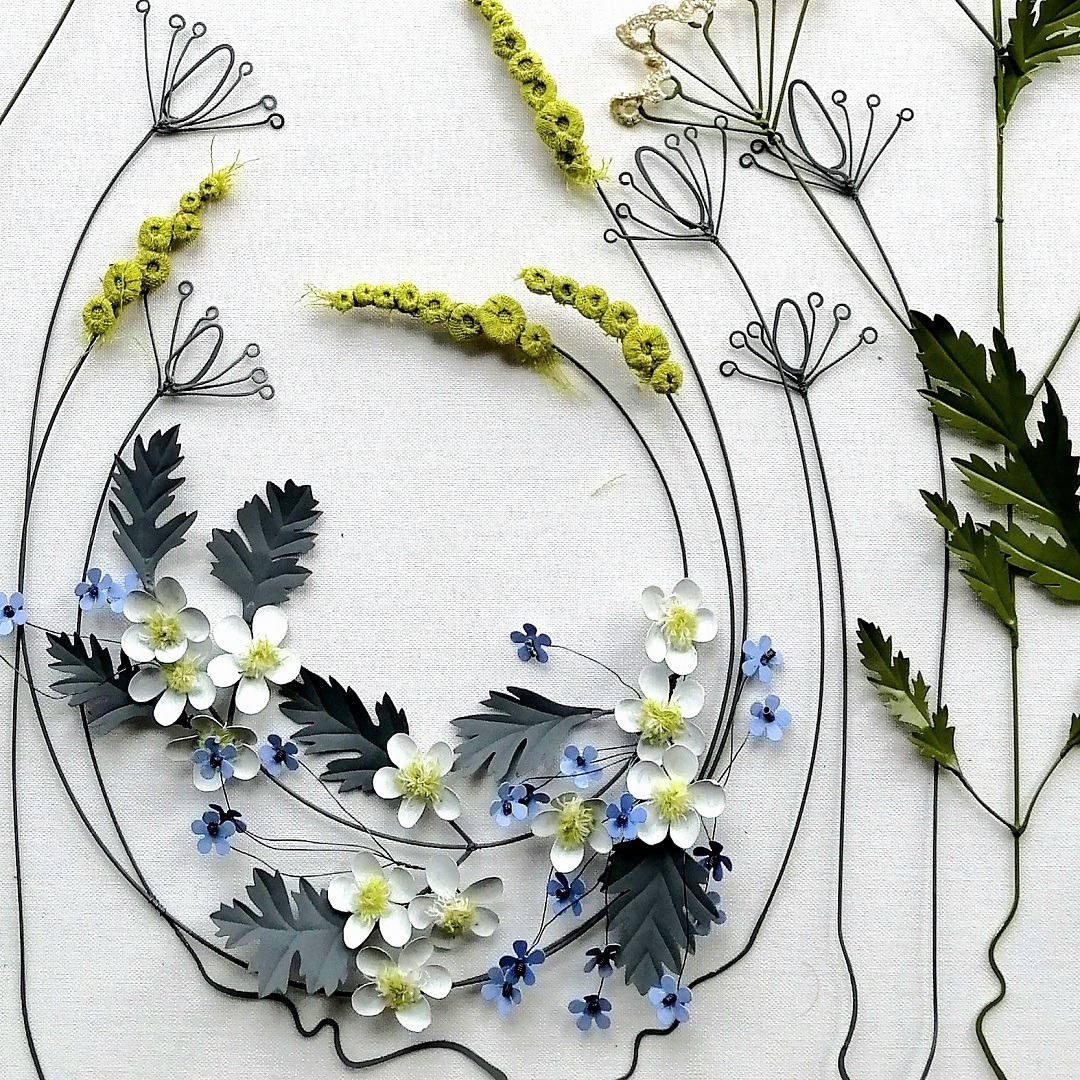
Liz Cooksey: ‘Walking my dog every day I’ve become very aware of the changing seasons. It is always a long haul getting through January and February.
What marks the change to spring for me is when cow parsley starts to edge the pathways. Its structure, delicacy and contrast to the winter months is an inspiration.’
Liz does not aim for a true representation in her work, but rather a likeness, using fine crochet along the top of the wire shapes to describe the small flower heads. With her artist’s eye she picks out the small and insignificant details that can often be overlooked.
Wire is used as a drawing material, bent to create structure, shape and line. Leaves and some of the hawthorn flowers have been cut from thin sheet metal. Liz hand dyes muslin to create the centre of the flower and fine lace-making thread – DMC 70 cordonnet special cotton – to combine all the elements with crochet, wrapping and hand stitching. The composition is then carefully pinned in place, slightly raised from the background providing a relief effect.
Liz’s many photographs form a useful reference dictionary of colours, textures and patterns.
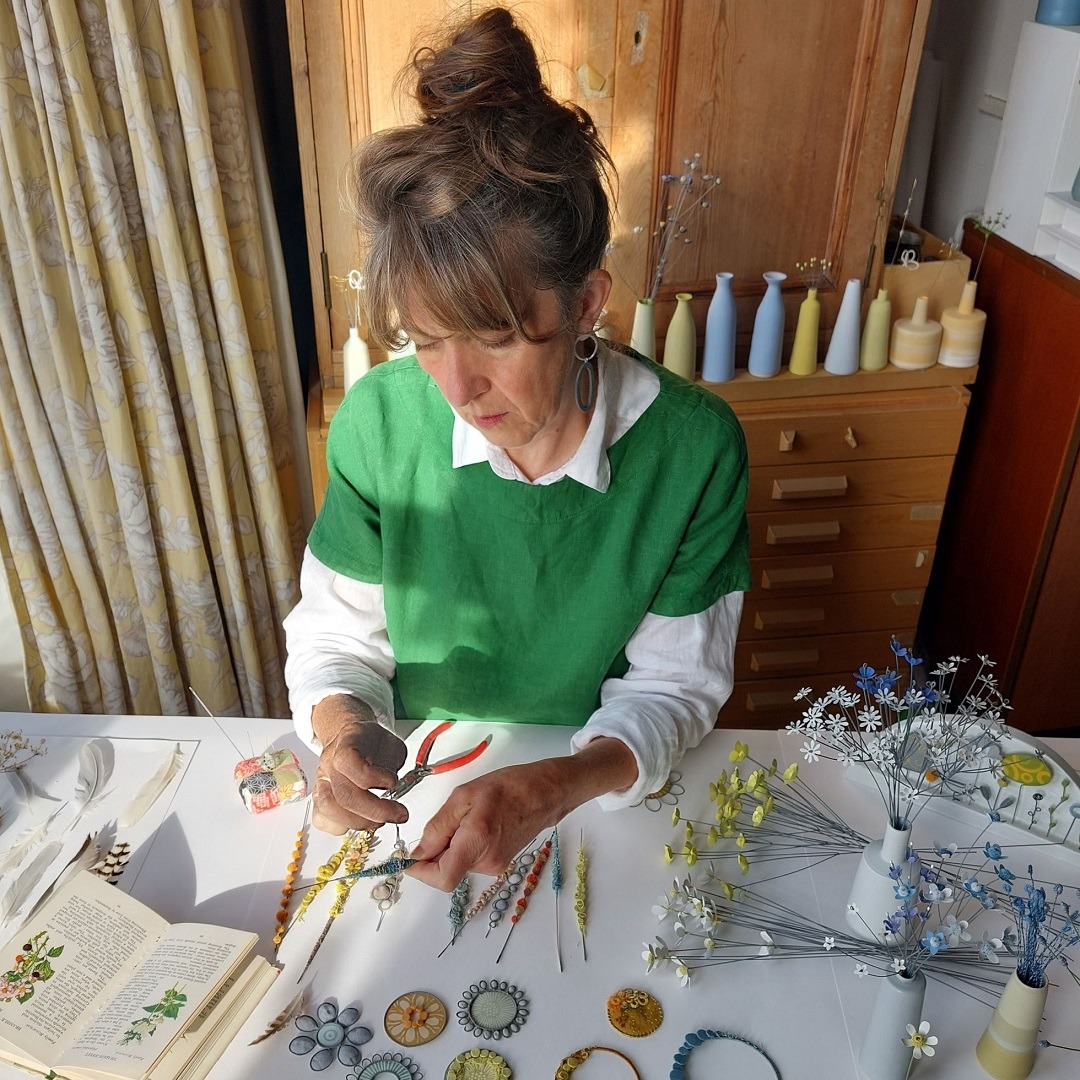
Liz Cooksey lives and works in Manchester where she studied embroidery at MMU. She went on to develop her own practice and teach textiles and fine art. Her two and three dimensional nature based works use mixed media with an emphasis on wire and crochet and are regularly exhibited in galleries and contemporary craft shows.
Website: lizcooksey.com
Instagram: @liz_cooksey
Lynn Comley
There’s a softness and airy mystery about felted florals, and in the case of Lynn Comley’s Summer Meadow, felt lends itself perfectly to the flowing swathes of ancient meadows.
Lynn Comley, better known as Up and Down Dale in the felt making world, creates wet felted textile art, and her love of flowers heavily influences her work. She works predominantly with sheep wool, combining other natural materials such as silk.
Lynn is another artist who takes inspiration from her daily dog walks, witnessing seasonal changes along the paths and hedgerows or the woodlands and moors. Favouring spring and early summer for their visible changes to the hedgerow flora, she strives to create both texture and little areas of interest that hold the eye, mark making with hand stitching.
Lynn Comley: ‘I love to depict flowers in my work, not only are they beautiful, but remembering their names as they emerge from their winter sleep is like welcoming back old friends or acquaintances.’
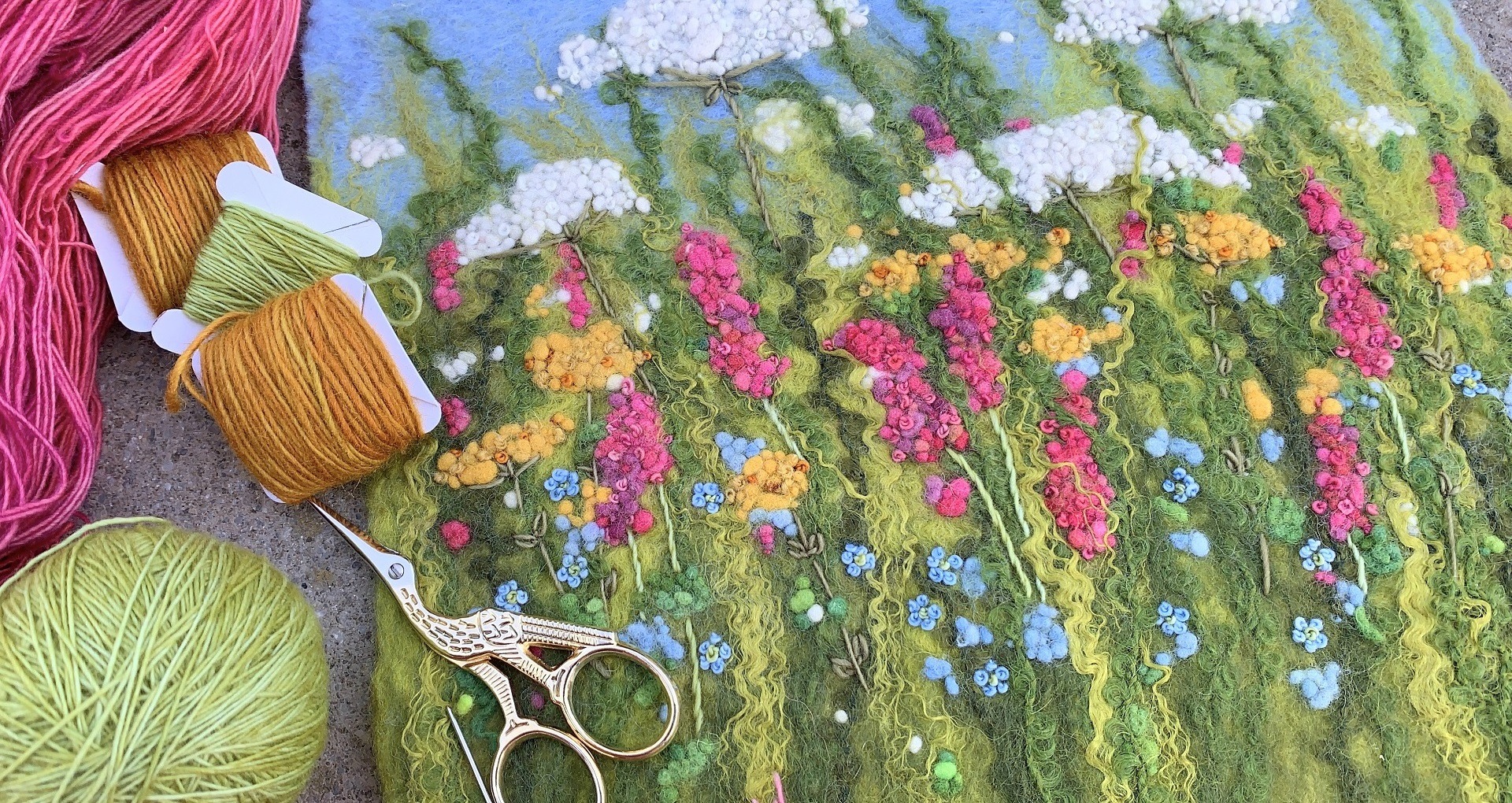
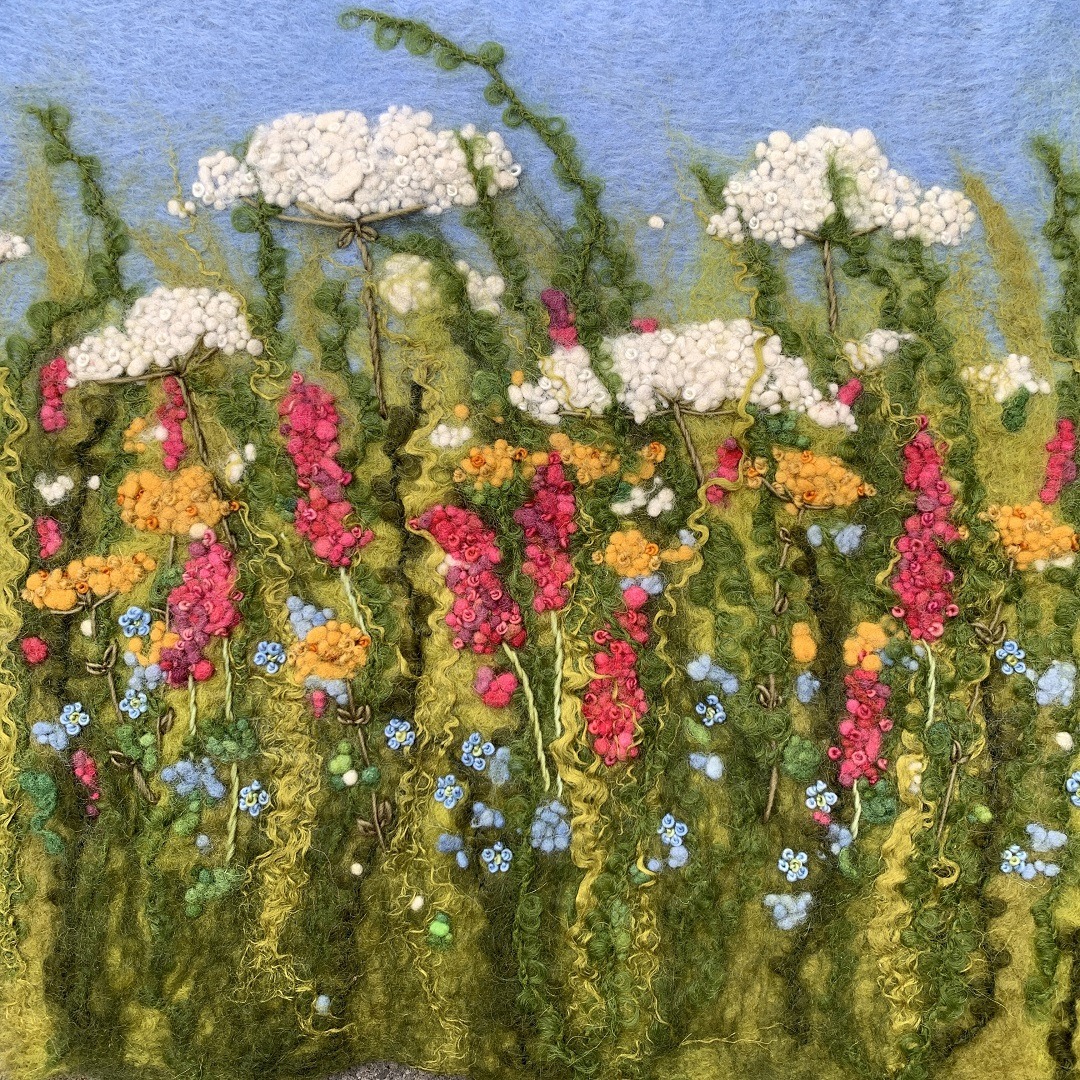
Summer Meadow is an amalgamation of hedgerow photographs. Lynn has always taken photographs, having what she terms an inbuilt impulse to document things that she finds evocative, such as the strength of the towering cow parsley down to intensely blue rambling, yet delicate, forget-me-nots of early summer.
‘Flowers, especially wild ones, cultivate naturally fighting for position, yet they thrive and harmonise within the surrounding landscape. I love their informal setting, unexpectedly coming across them on my walks, which creates the urge to rush home and produce a new piece of work.
‘Handcrafted felt is a wonderful fabric that lends itself to freeform stitching. Stems of flowers can be subtly skimmed just under the surface, stitches can be worked closely together and pulled tighter, so the thread disappears, but an impression, a hint of something, remains visible.
‘I adapt the stitch element of my design to incorporate or leave these areas untouched.
‘Wool felt is not a fabric where an intricate pattern can easily be transferred. So, as in Summer Meadow, all my work is totally freeform. Yes, I have a plan, a design in mind, but adapt it as I go along. I enjoy the freedom, the journey that the needle and thread take me on.
‘Most of all I like the quiet stitching time, the harmony of stitching with beautiful hand dyed yarns onto a unique piece of cloth that I have made. The time spent and connection back to nature, the remembered walk, will always be my favourite part of the whole process.
‘Summer Meadow epitomises my love of flowers and making it allows me to share my joy with others.’
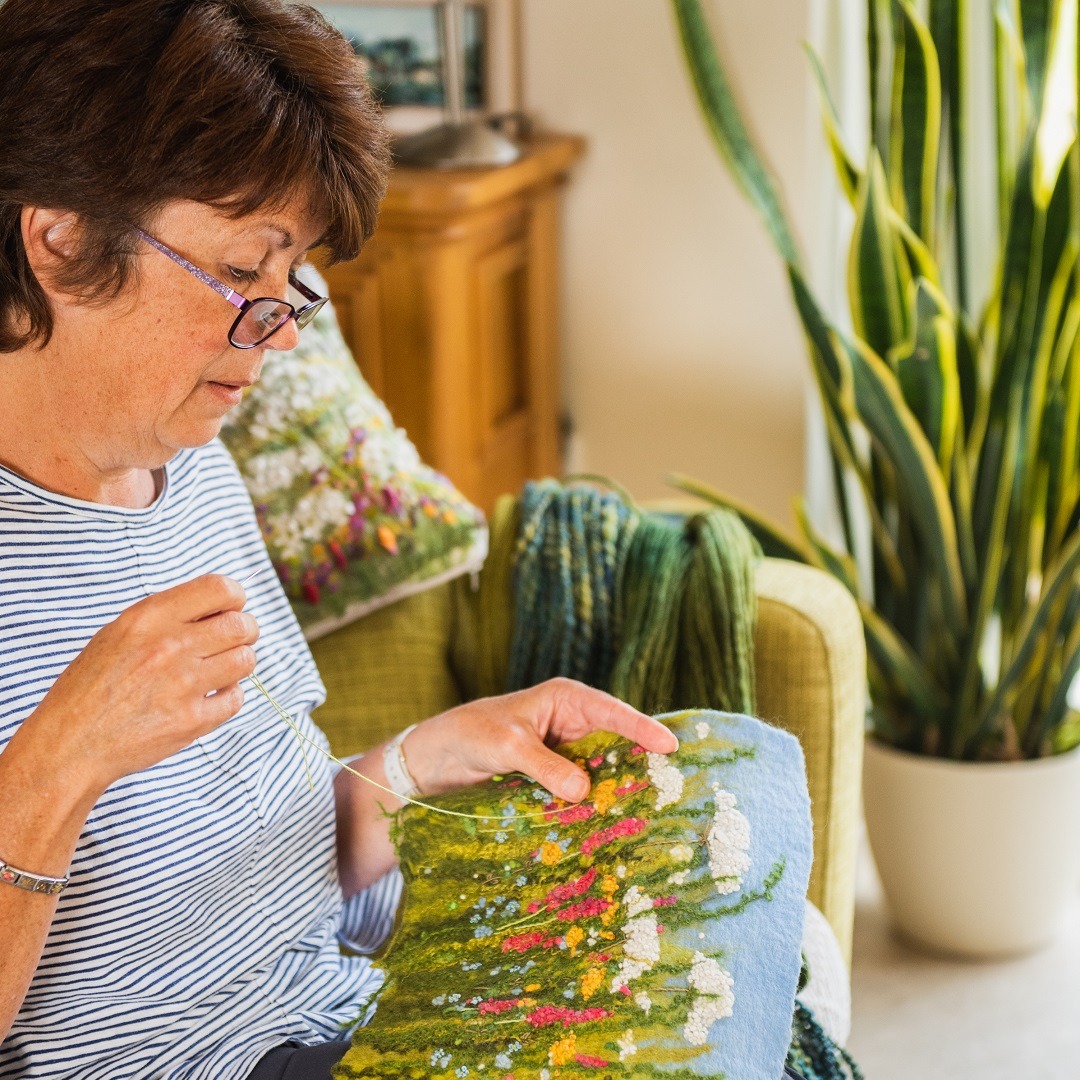
Lynn Comley better known as Up and Down Dale, creates wet felted textile art. Lynn is a co-founder of Embracing Wool, a collective of artisans working primarily with wool who exhibit in beautiful formal garden settings.
Website: upanddowndale.co.uk/
Facebook: facebook.com/UpandDownDale
Instagram: @upanddowndale
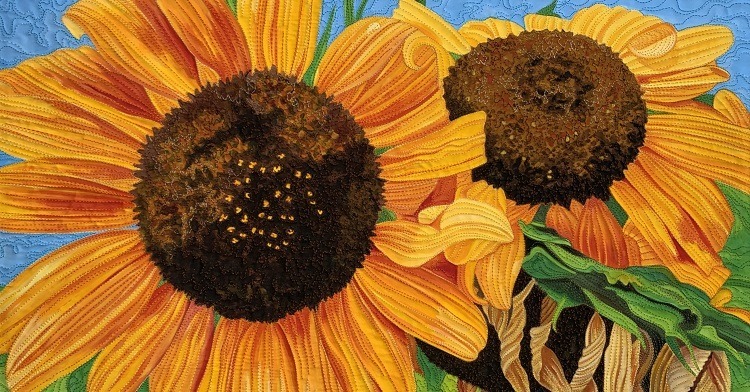
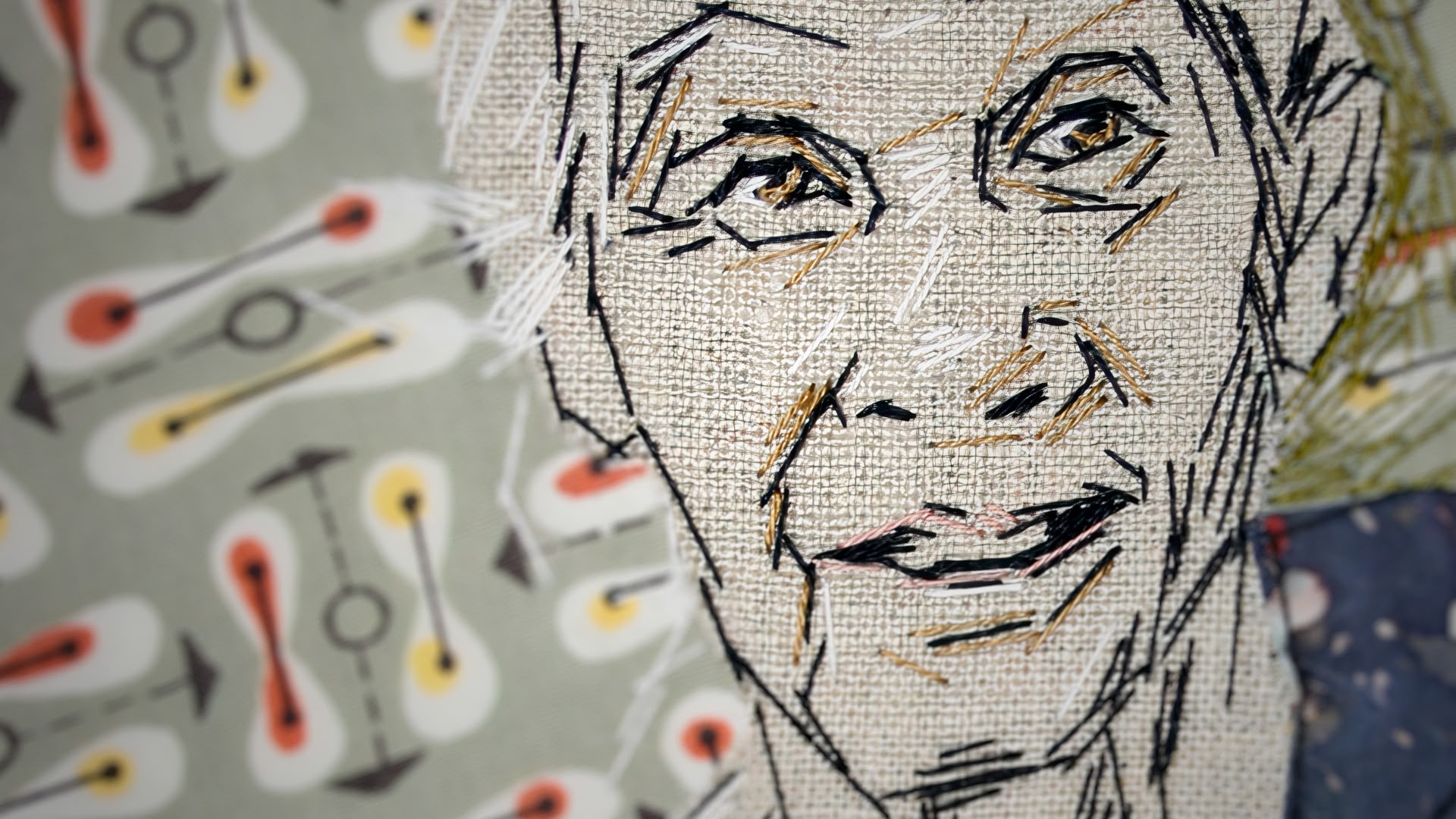
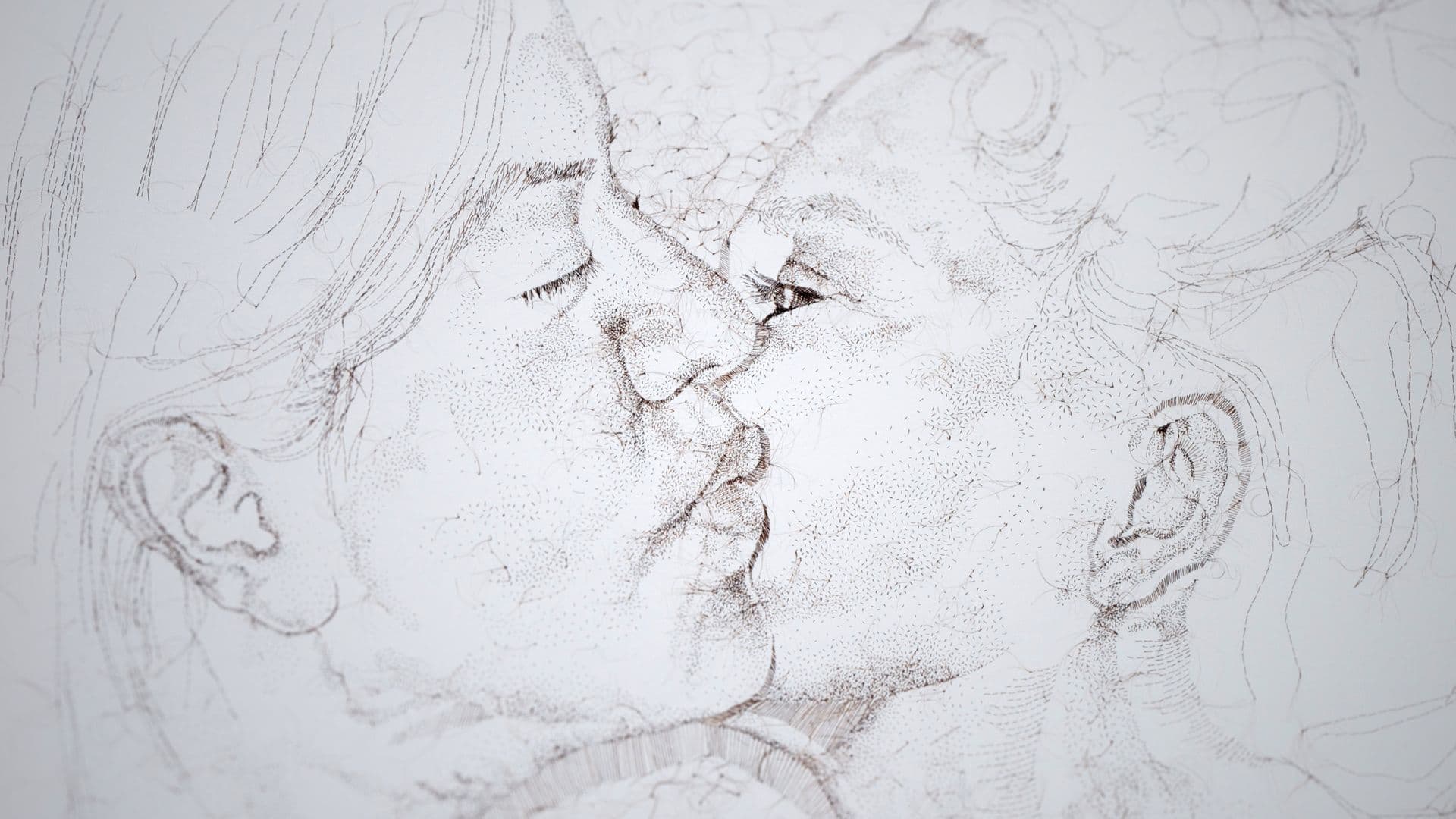
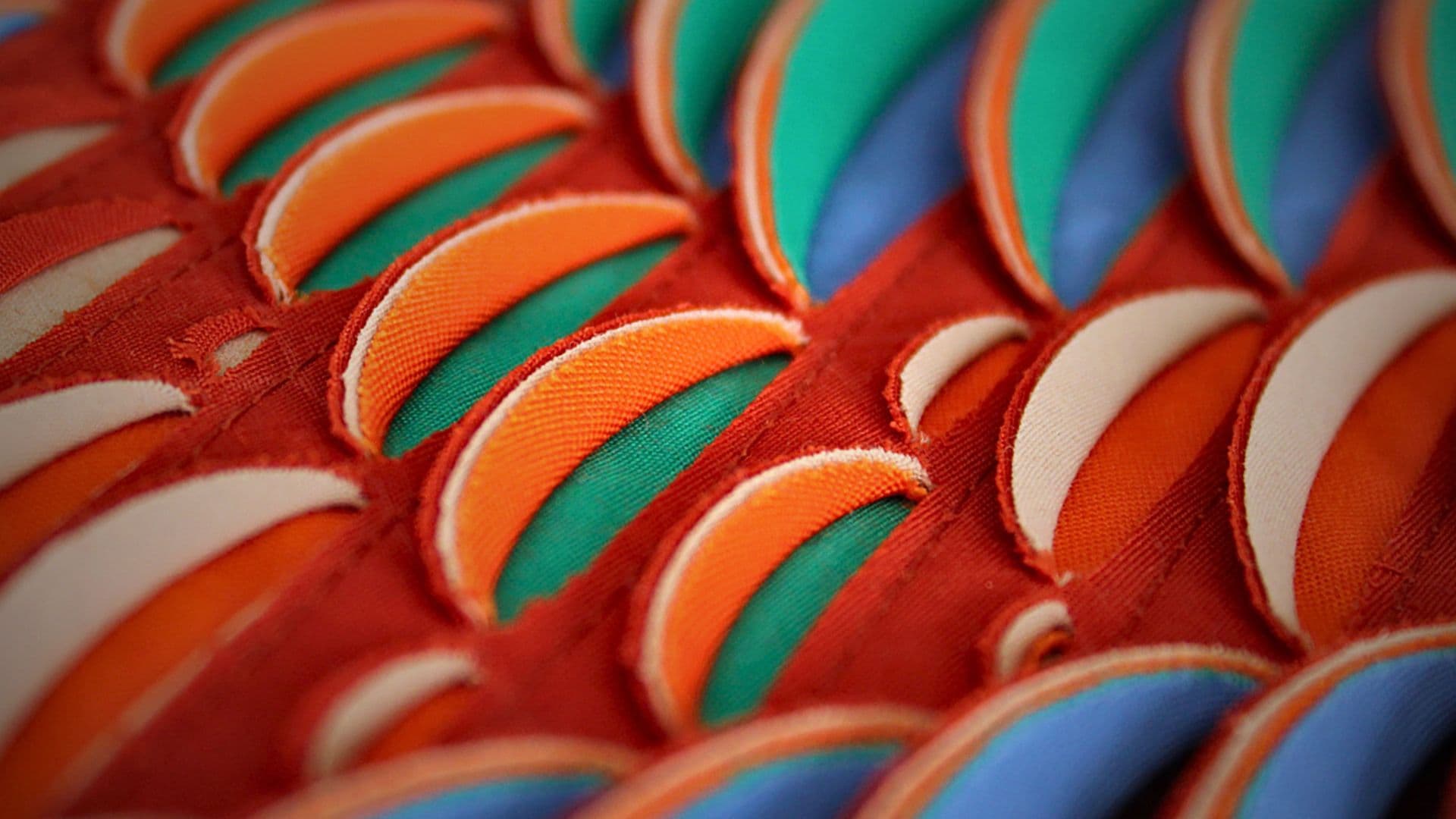

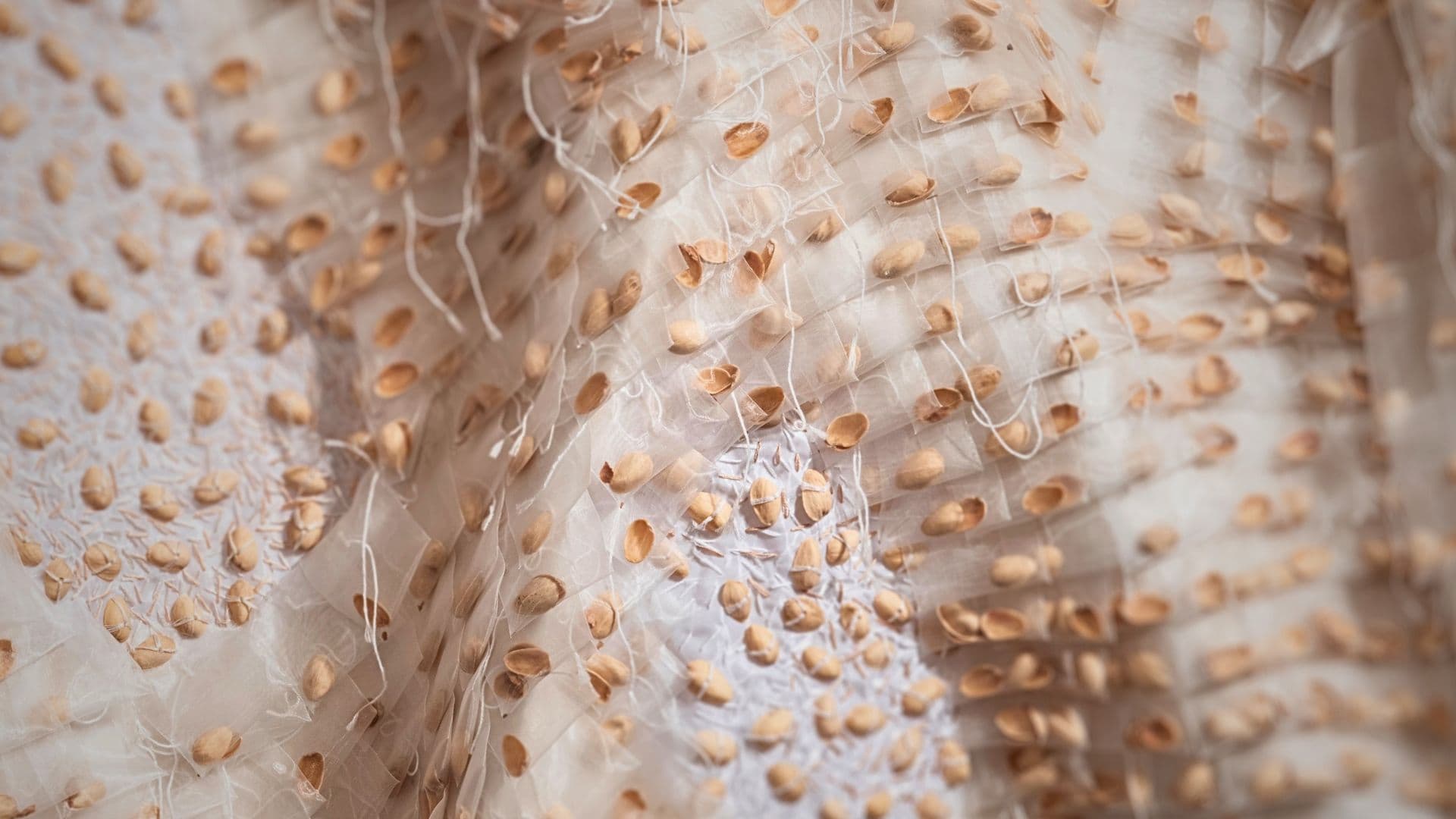
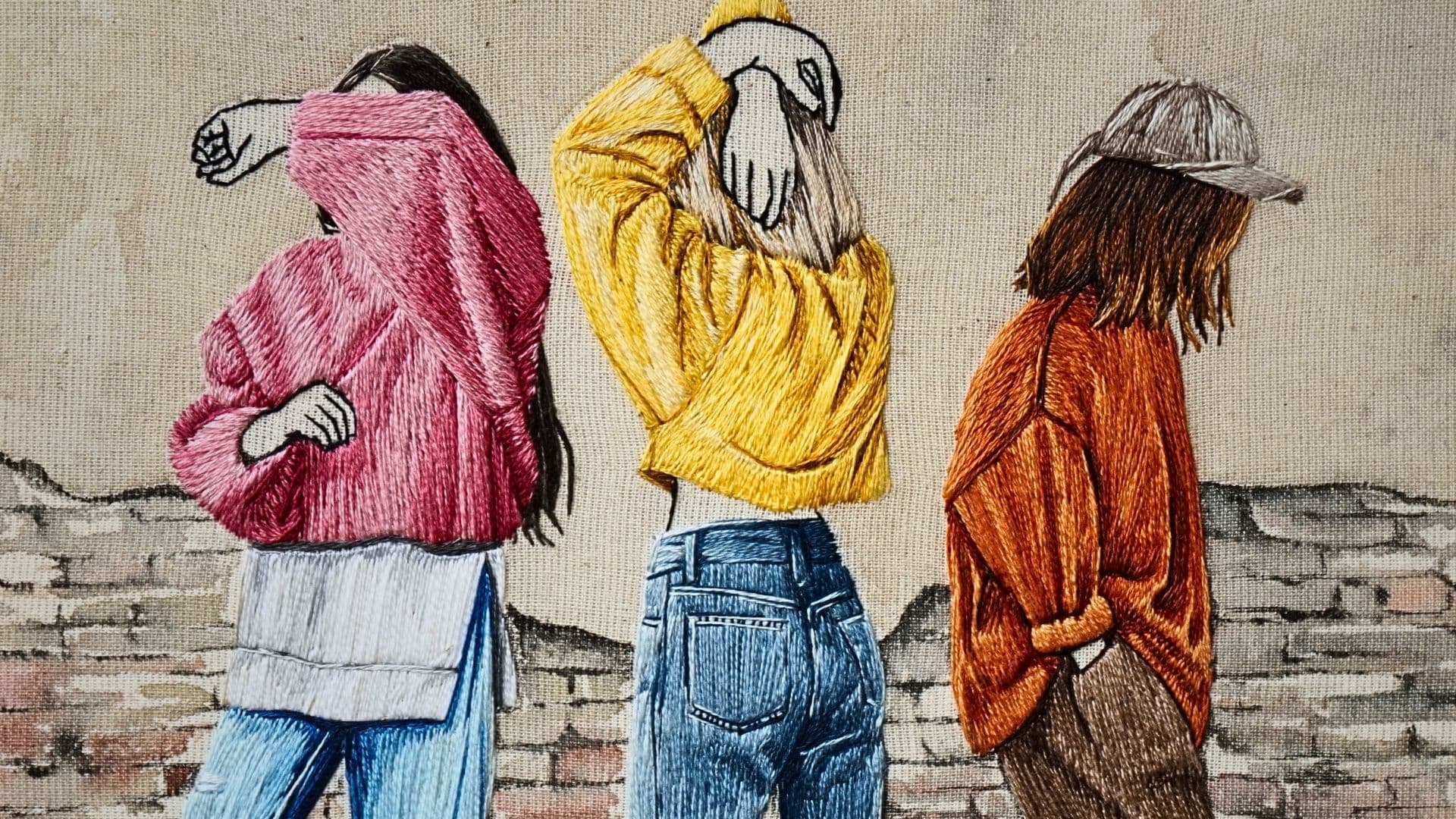
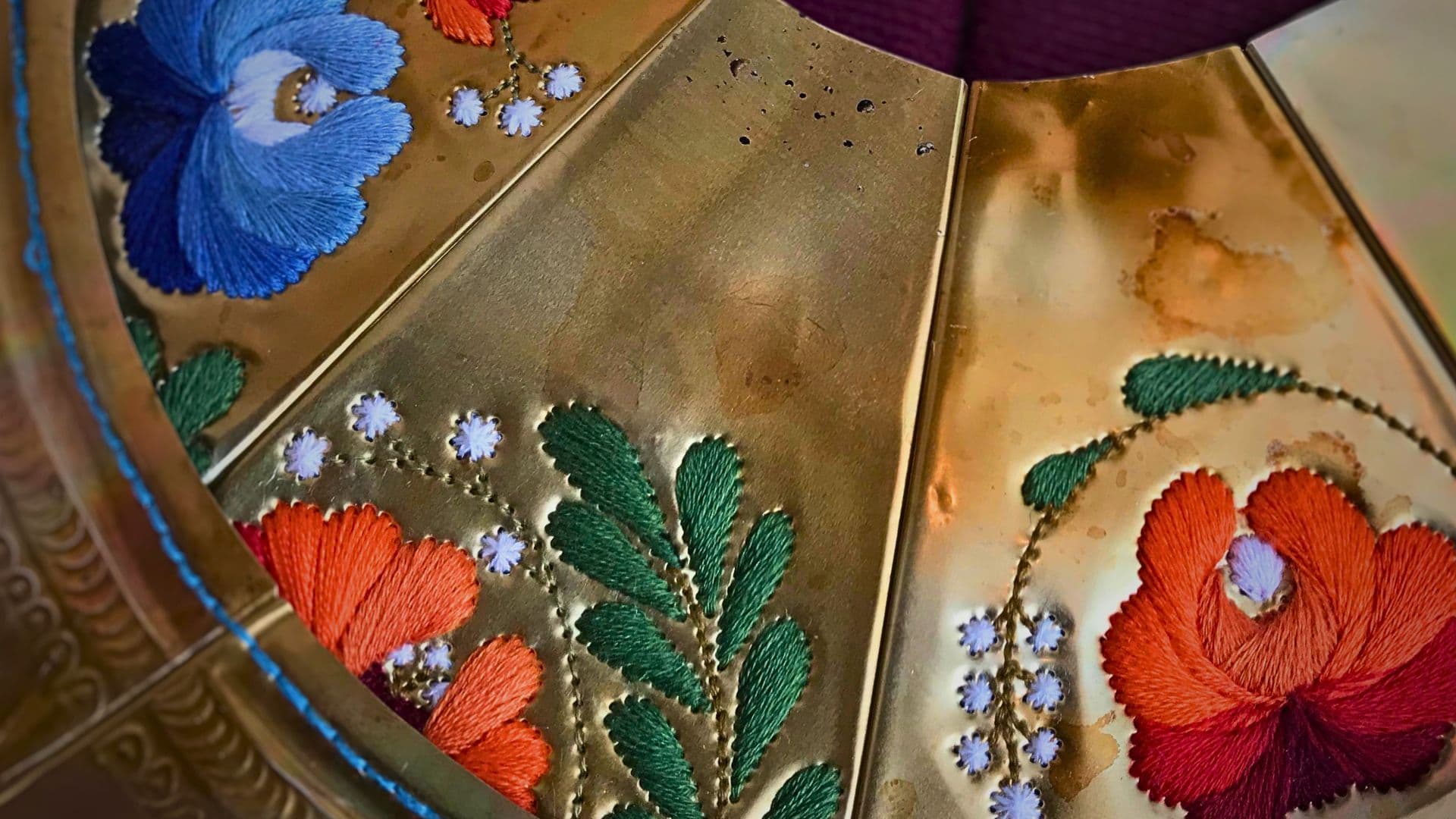
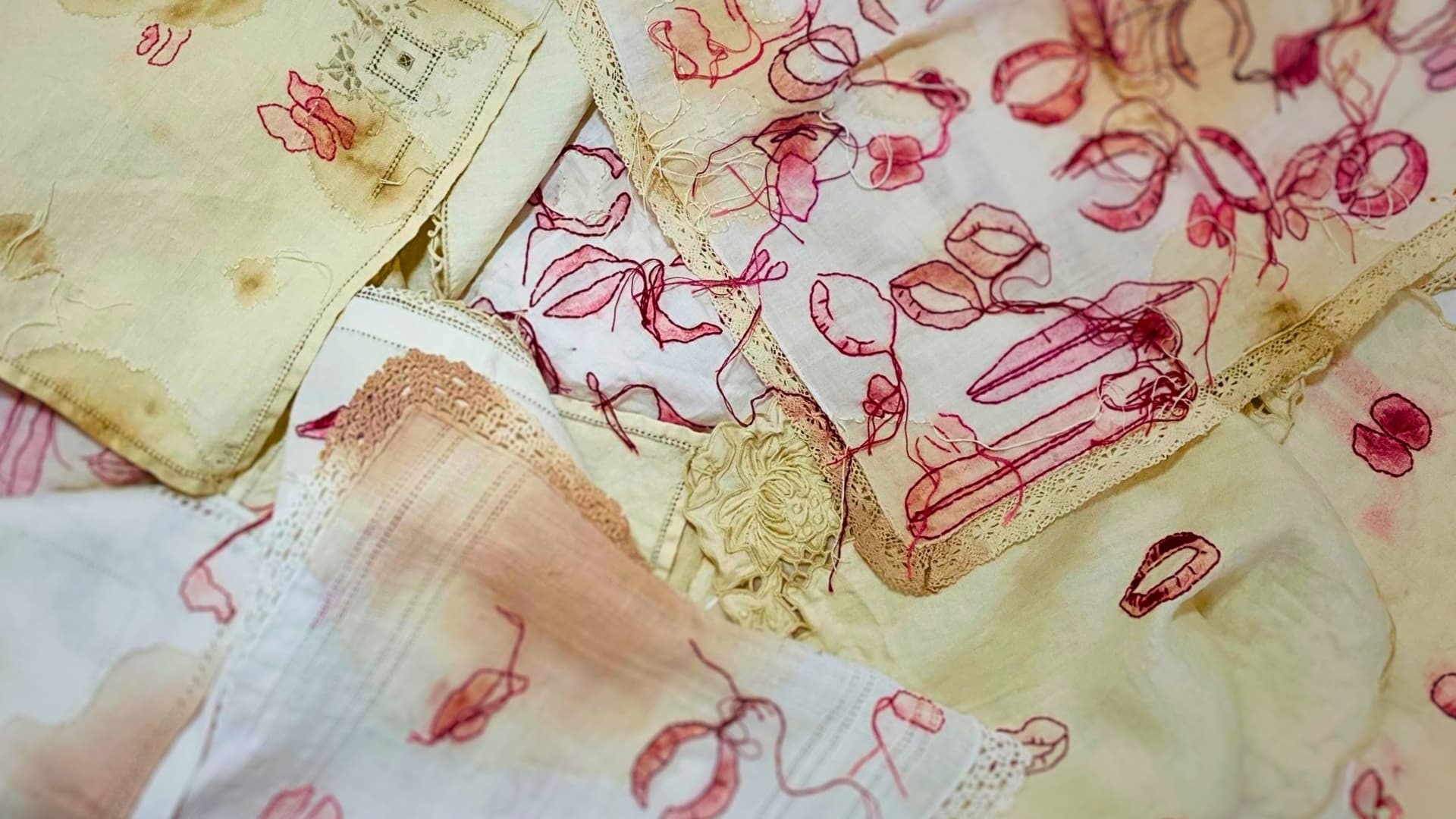
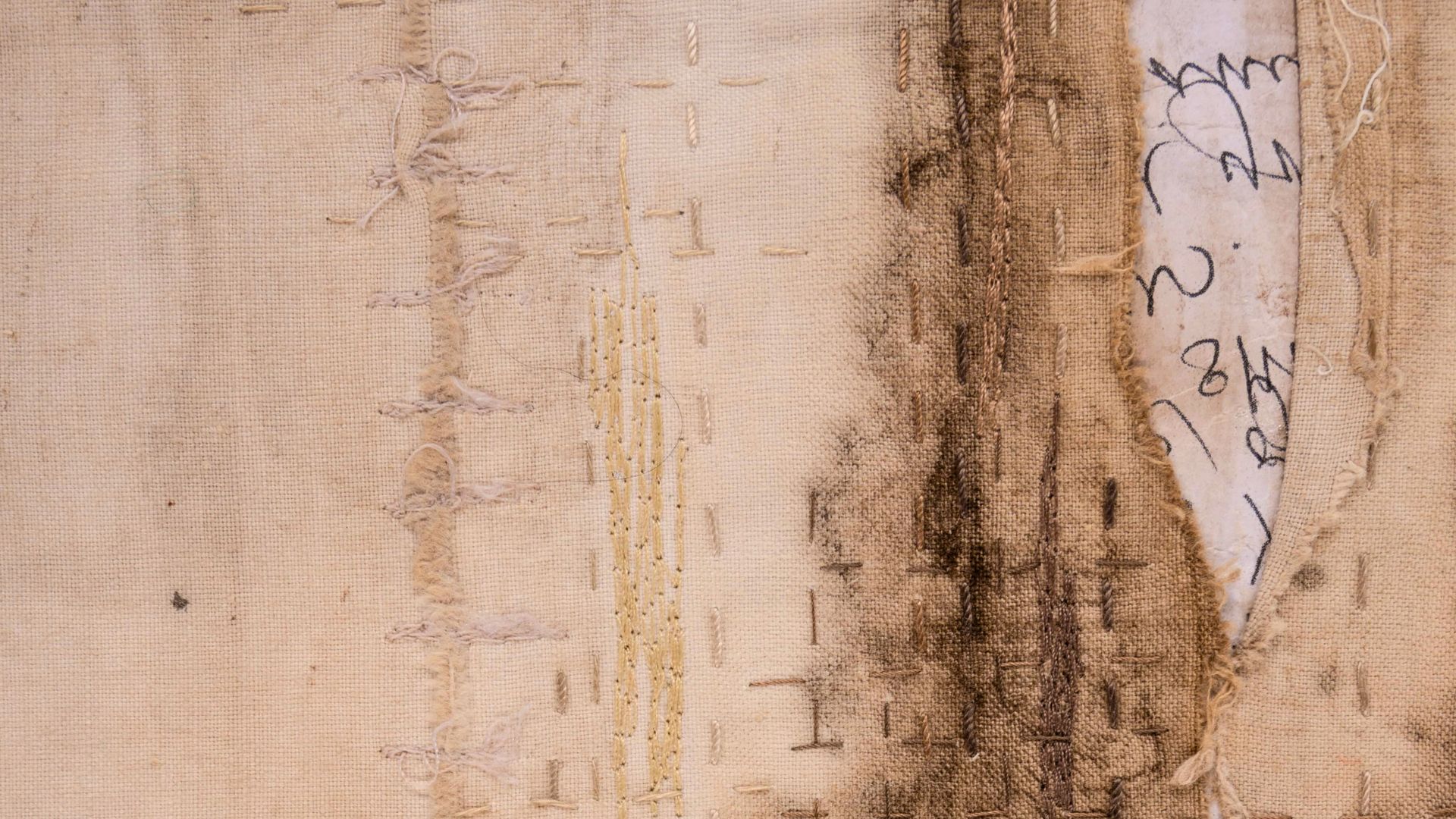
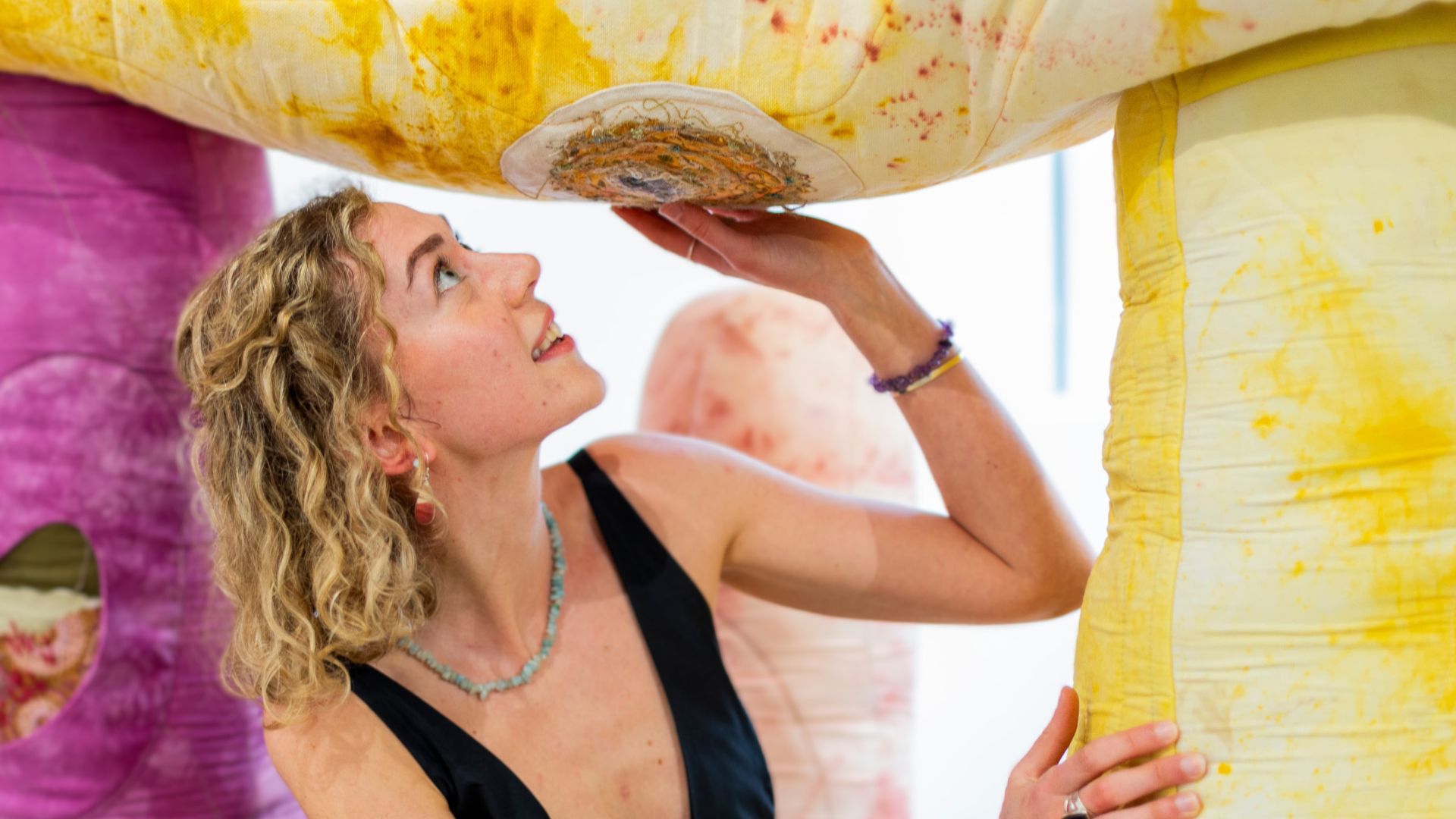
Comments